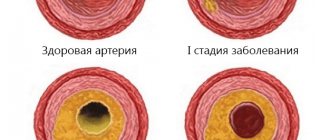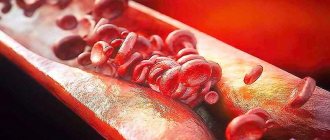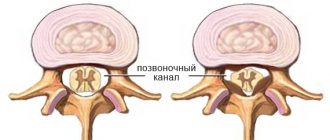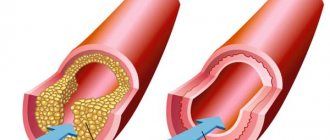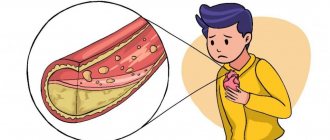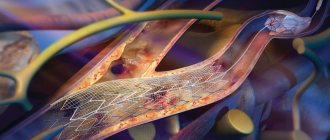Atherosclerosis of the renal arteries involves thickening of the walls and narrowing of the lumen of the renal arteries as a result of cholesterol deposits inside the vessel. In most cases, it occurs as a chronic disease that impairs the blood supply to the kidneys. The main danger is the risk of renovascular symptomatic hypertension, which entails a threat to the patient’s life. In another case, chronic lack of blood supply can lead to the development of renal failure.
Risk factors include:
- elderly age;
- hereditary predisposition;
- smoking and alcohol;
- sedentary lifestyle;
- diabetes;
- excessive consumption of fatty and fried foods;
- overweight.
Symptoms
During its development, atherosclerosis of the renal arteries goes through several stages:
Latent stage - during this period there are no symptoms of the disease, and the presence of pathology can only be seen using laboratory and instrumental research methods. This stage can last for several years.
Stage 1 of the disease - an increase in ischemic disorders occurs in the kidney tissues, and the only symptom is an increase in blood pressure. In addition, an increase in protein can be seen in a urine test.
Stage 2 of the disease – the process of blood clot formation begins in the renal vessels. This is accompanied by symptoms of general intoxication in the form of vomiting and fever. In addition, there is pain in the lower back with irradiation to the lower abdomen and groin area.
Stage 3 of the disease – the nephrons of the kidneys begin to die, which entails the formation of renal failure and more severe arterial hypertension.
Causes of development of renal artery stenosis
Among the diseases that provoke renal artery stenosis, the most common are atherosclerosis and fibromuscular dysplasia .
Atherosclerotic, that is, accompanied by the formation of plaques in the arteries from pieces of tissue detached from the walls, renal artery stenosis is usually a companion to diabetes mellitus, coronary heart disease or arterial hypertension.
In this case, plaques in most cases are concentrated in the area of the aorta, which is fraught with the most severe consequences for the patient.
Fibromuscular dysplasia as a cause of stenosis is often a hereditary pathology and is much more common in women aged 30-45 years. This disease is a thickening of fibrosis or muscle tissue covering the tissue of artery walls.
In some cases, renal artery stenosis can be provoked by arterial aneurysms, arteriovenous shunts, nonspecific aortoarteritis, thrombosis or embolism of the renal arteries, compression of the renal vessels by a foreign body or tumor, and nephroptosis.
Treatment
Treatment begins with eliminating provoking factors, namely adjusting the diet, increasing physical activity, eliminating bad habits, and so on.
The nephrologist selects an individual treatment regimen for each patient, depending on the stage of the disease and the degree of changes in the renal tissue. Drug treatment is carried out with the help of antiplatelet agents, angioprotectors, antispasmodics, lipid-lowering agents and hypertensive therapy.
In case of advanced disease and a high risk of blood clots, surgical treatment is used. There are three main methods of surgical interventions:
- stenting;
- bypass;
- prosthetics.
With timely treatment of this condition, there is every opportunity to avoid further complications and make a favorable prognosis for the patient’s life.
| Name of service (price list incomplete) | Price, rub.) | In installments* |
| Appointment (examination, consultation) with a cardiovascular surgeon, primary, therapeutic and diagnostic, outpatient | 1 750 | — |
| Program “Risk of atherosclerosis and ischemic heart disease, predisposition to dyslipidemia” | 19 000 | — |
* You can read more about the conditions here - Treatment on credit or in installments.
General information about atherosclerosis
A constant increase in the level of cholesterol and other lipids in the blood leads to their penetration and accumulation in the walls of arteries in places where they are subject to heavy pressure load (aorta, coronary vessels, brain arterioles, vessels of the lower extremities and intestines). This leads to a narrowing of the lumen of the arteries and disruption of the blood supply to organs. Blood flow is hampered by both the atherosclerotic plaque itself and the blood clots that appear in these places. This process is especially dangerous for the heart and brain.
Mechanism of development of atherosclerosis
The main role in the pathogenesis of the disease is played by an imbalance between blood lipid fractions. With a decrease in the level of high-density lipoproteins (found in vegetable fats, fish, seafood, cheese) and an increase in high-density lipoproteins (animal fats), the latter are deposited in the wall of blood vessels. This is preceded by local damage to the inner wall of the arteries. Smoking, low levels of antioxidants, and certain viruses and bacteria play a role in this.
Stages of development of atherosclerotic disorders:
- Lipid spot stage
. The plaque does not rise above the level of the vessel wall, does not manifest itself clinically, and is not determined by any research methods during life. - Stage of liposclerosis
. Connective tissue fibers grow into the lipid mass. This makes the plaque more dense, it protrudes into the lumen of the vessel and impedes blood flow in this area. - Stage of atherocalcinosis
. Foci of calcification appear in the plaque and salts are deposited. The plaque completely hardens and is not subject to reverse development. This is where ulceration of the plaque and blood clotting in the vessel begins, which leads to thrombosis.
Treatment of major renal vascular abnormalities
Stenosis, the basic symptom of which is very high blood pressure, requires complex drug therapy. Typically these are blood pressure lowering drugs and diuretics.
The use of medications, as a rule, is additional to surgical techniques , since the very cause of the disease does not eliminate the use of drugs, and the disease progresses. Stenosis confirmed by diagnostic measures is an indication for surgical intervention. Most often these are the following operations:
· Shunting . Shunts create blood flow that bypasses the pathological area of the artery.
· Angioplasty . An inflating balloon is inserted into the artery to widen it.
· Stenting. The vessel is expanded with stents - springy or mesh devices.
· Prosthetics . The operation is performed if it is impossible to perform angioplasty or stenting. The narrowed area is excised and an implant is placed in its place.
· Nephrectomy . During this operation, the indication for which is multiple stenosis, a practically non-functioning kidney is removed.
If stenosis is not treated, a third of patients are likely to die from strokes, heart attacks, and acute renal failure.
If an aneurysm , surgery is usually performed. In the most severe cases, the kidney is removed. But if the aneurysm does not grow, doctors resort not to open traditional operations, but to minimally invasive techniques. For example, during obliteration, a catheter with a special substance is inserted into the aneurysm, which immediately hardens, “bricking up” the pathological section of the artery.
Who is at risk
Every person, regardless of gender and age, can develop atherosclerosis of the coronary arteries. This is facilitated by many factors, ranging from social reasons to poor ecology. Guidelines for assessing risk factors for the development of cardiovascular diseases, developed on the basis of many years of research in the field of cardiology, highlight the following indicators:
- Men aged 50-55 years;
- Difficult working conditions due to professional activities;
- Hereditary heart pathologies;
- Obesity;
- Smoking, including passive smoking;
- Psychological disorders – stress, depression, depression;
- Thyroid diseases;
- Poor nutrition, the definition includes fried, fatty, sweet and flour foods, fast food.
A systemic risk assessment for the next 10 years can be made independently using the well-known SCORE (Systemic COronary Risk Evaluation) scale proposed by American cardiologists. The modern pace and rules of life put every second person at risk. Therefore, it is difficult to find a better prevention of atherosclerosis of the heart vessels than regular preventive examinations. At the slightest suspicion, it is better to consult a cardiologist and adjust your lifestyle than to undergo long-term treatment, which does not always have a positive outcome.
Atherosclerosis of the cerebral arteries
When cholesterol plaques form and the arteries of the brain narrow, the brain cells experience a lack of blood and nutrients. The following symptoms may indicate this condition:
- periodic dizziness,
- noise in ears,
- headache,
- increased fatigue,
- disturbances in coordination of movements.
The narrowing of the main carotid artery supplying the brain is identified as a separate diagnosis - carotid artery stenosis. Damage to the vessels supplying the brain carries the threat of a serious disease - ischemic stroke of the brain.
Basic diagnostic methods:
- Clinical method
- more than half of the information about atherosclerotic lesions comes from a thorough initial examination of the patient, collection of complaints and anamnesis of the disease. - Electrocardiography (ECG)
- shows changes in the heart muscle and heart function caused by atherosclerosis. - Daily monitoring of the electrocardiogram according to Holter
is a widespread method of functional diagnostics, which is used to detect heart rhythm disturbances and ischemic (atherosclerotic) changes in the heart muscle. - Bicycle ergometry
- evaluates the functioning of the respiratory and cardiovascular systems during physical activity, and, in the presence of pathology, is able to identify insufficient function of organs affected by atherosclerosis - Echocardiography
- using ultrasound waves, the work of all parts of the heart is assessed in real time. - Duplex scanning of arteries
is a visual diagnostic method that allows you to “see” the degree of narrowing of the vascular bed, assess the size and structure of the atherosclerotic plaque, its integrity and measure the speed of impaired blood flow in the affected artery. - Magnetic resonance imaging angiography
(MRI angiography) is one of the newest methods for diagnosing vascular diseases. It is possible to obtain images of the vessels of the head and neck without the introduction of any contrast agents. The absence of radiation exposure makes this study absolutely safe for humans. - Multislice computed tomography angiography
allows screening patients for surgical treatment on an outpatient basis due to the non-invasiveness of the method, effectively solving complex diagnostic problems based on the data obtained on the topography of anatomical areas in three-dimensional reconstruction mode, and visualizing any vessels of the human body more than 2 mm in diameter. - Angiography
is the diagnosis of atherosclerotic lesions of almost any arterial system, with visualization of the degree of stenosis, the relationship of the arteries with the surrounding anatomical structures, and possible individual variations in the structure of the arterial bed. The method is considered invasive (requiring surgical intervention), and is prescribed according to strict indications, when the question of possible surgery arises.
Forecast and prevention of atherosclerosis
The prognosis for a person with atherosclerosis is mixed. If he adheres to the doctor’s recommendations (diet, quitting smoking and alcohol, drug treatment), then the prognosis is favorable, and the growth of plaques can be slowed down. For patients who do not heed these recommendations, the picture is sadder: the risk of myocardial infarction and stroke increases significantly.
Basic preventive measures:
- less animal fats, more vegetable oils;
- sufficient amount of vitamins and microelements;
- to give up smoking;
- limiting alcohol consumption;
- physical activity, normalization of body weight;
- avoidance of emotional stress and worries.
Symptoms
Signs of arterial pathologies may vary for different anomalies.
For example, the main signs of stenosis (the most common pathology of the artery in the kidney - up to 2/3 of all cases of such kidney diseases), in addition to high blood pressure, are:
· Pain: headache, behind the sternum, in the lower back, in the eyes.
· Feeling of noise in the ears.
· Shortness of breath.
· Tachycardia.
· Presence of a small amount of protein in the urine.
· Uneven pressure on the right and left sides of the body.
The presence of aneurysm may have no symptoms at all until the dilation becomes very large or the aneurysm ruptures. If the dilatation is large, the ureter is compressed, the functioning of the kidney is significantly impaired, and infection with urinary toxins occurs. There is weakness, headache, and the smell of acetone.
When an aneurysm ruptures, the renal artery becomes blocked. If the patient is not immediately taken to the vascular surgery department, there is a high risk of death.
Atherosclerosis of the arteries of the lower extremities
Damage to the arteries of the lower extremities is called obliterating atherosclerosis. People over 65 years of age, especially men, are susceptible to it. This disease manifests itself in the following symptoms:
- pain in the calves, cramps at rest;
- pain when walking, causing you to limp;
- numbness in the legs, fatigue when walking;
- the appearance of non-healing wounds, and in advanced cases - ulcers.
If you do not consult a doctor in the presence of such symptoms, then there will be a threat of limb amputation as the only treatment measure for extremely advanced cases of obliterating atherosclerosis.
Risk factors for the development of atherosclerosis
All factors that can lead to the development of atherosclerotic lesions can be divided into 3 groups: controllable (we can influence them), uncontrollable and relatively controllable.
Controllable risk factors:
- a diet rich in animal fats, trans fats, insufficient consumption of plant foods;
- smoking;
- sedentary lifestyle.
Uncontrollable risk factors:
- heredity;
- age over 55 years;
- male gender.
Relatively controllable factors
ー chronic diseases that lead to metabolic disorders. They cannot be cured, but can be controlled with diet and medication. These include type 2 diabetes mellitus, hypertension, obesity, and severe infectious diseases (for example, tuberculosis).
Diagnosis and treatment of atherosclerosis in Medical
When should you see a doctor?
If the described symptoms appear, you should consult a cardiologist. Also, if there are risk factors, a preventive examination is recommended once a year.
You should not treat atherosclerosis using traditional methods! There are no traditional medicines that would help dissolve atherosclerotic plaques, and medications should be taken only in the dosage prescribed by the doctor.
Drug treatment
Patients with atherosclerotic artery disease are prescribed drugs that lower blood cholesterol levels, antihypertensive, antithrombotic, vitamin and antioxidant complexes.
Surgery
The main goal of surgical treatment is to restore blood flow in tissues. This can be achieved by widening the narrowed artery (installation of a stent), creating a collateral blood supply (bypass surgery).
Coronary artery bypass grafting
The principle of the method is to create an additional vessel between the aorta and the area of the affected coronary artery beyond the plaque. To do this, a section of the saphenous vein is taken from the patient’s lower leg.
